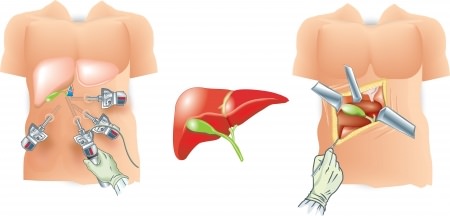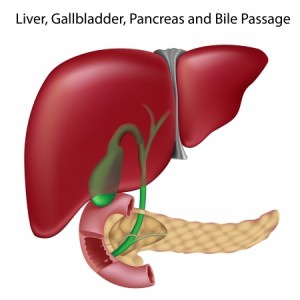What is the function of the gallbladder?
Liver (Red), Gallbladder (Green) and Pancreas (Tan)[/caption] The gallbladder is a pear shaped hollow organ that is located under the right lobe of the liver. The gallbladder is connected to the liver by a network of tubes that are referred to as ducts. The primary function of the gallbladder is to store and concentrate bile. Bile is made in the liver and is secreted into the duct system. The bile travels from the liver and enters the small intestine within inches from the stomach. Bile enables the fats and oils we eat to be digested and made soluble in a water environment. This allows fats and oils as well as certain fat soluble vitamins to enter into the body and be used as a source fuel or to meet other metabolic needs. When there is a surplus of bile production by the liver the gallbladder becomes a storage depot. The “extra” bile can be stored and concentrated in the gallbladder. When a meal requires a larger volume of bile the gallbladder is triggered to contract and provide an additional amount of bile to aid in digestion.
Why do gallstones form?
Bile is composed of water, cholesterol, bile acids and bile salts. It is believed that gallstone formation is the result of an imbalance of physiologic concentrations of one or more of the components. As a result, the bile can begin to crystallize and eventually form larger stones.
Do I need a gallbladder?
The gallbladder is not a vital organ. If your gallbladder is causing recurrent symptoms most people benefit from having it removed. Approximately 1L of bile is made by the liver every day. Only 40-75 ml of bile is stored within the gallbladder. Some patients may note some increased bloating, gas or loose stools after gallbladder removal. This is usually very short lived and in time would be expected to disappear. I always recommend that patients stay on a “heart friendly diet” for 2 to 4 weeks after surgery.
What are the symptoms of having a gallbladder problem?
Patients often experience intermittent episodes of what they feel is “indigestion”. There may be a sense of feeling full or bloated. Sometimes there is associated discomfort just below the sternum. Often, patients experience nausea and vomiting. Loose stools or diarrhea may also occur. The discomfort is usually triggered by eating, especially meals rich in fats and oils, although this is not always the situation. The truth is any food can lead to a gallbladder issues in the presence of gallstones. When a fulminate gallbladder attack occurs the pain is much more intense as is the nausea and vomiting. The pain may migrate to the right upper quadrant of the abdomen and around into the back. Some patients may also experience right shoulder discomfort. During severe flares people may also develop signs of infection such as fevers and chills.
What problems do gallstones cause?
The most common symptom of gallstone disease is pain and indigestion. The pain may last for minutes or hours. The mechanism that leads to symptoms is the result of a gallstone becoming lodged in the neck of the gallbladder. The gallbladder is essentially blocked resulting in gallbladder distension and consequently inflammation and pain.
Passage of gallstones is a common cause of pancreatitis. In some cases gallstones can pass into the common bile duct. The common bile duct enters the small intestine through a common opening with the pancreatic duct. Sometimes as the stone passes it can lead to inflammation of the pancreas, known as pancreatitis. Pancreatitis can be very problematic and is a strong indicator to remove the gallbladder.
On occasion, a stone can become lodged in the biliary tree causing a bile flow obstruction and potentially leading to a severe infection presenting with high fevers, pain and jaundice (yellowing of the skins/eyes). This is known as cholangitis and if not managed quickly it can be life threatening.
How are gallstones diagnosed?
The best imaging study for gallstones is ultrasound (U/S). U/S uses sound waves to obtain images of the gallbladder, liver and biliary tree. The majority of gallstones can be picked up using this technique. There is no exposure to radiation and can be repeated frequently if needed.
On occasion, other tests can be used to confirm the severity of a gallbladder problem. The most frequently used test is a HIDA scan. In this test a small amount of radiotracer is given to the patient through an IV. The tracer is taken up by the liver and excreted into the bile. The images obtained can provide information of whether or not the gallbladder is plugged by a stone. In addition, the same test can be used to estimate gallbladder function by measuring how much bile the gallbladder ejects when stimulated.
How is the gallbladder removed?

Left: Laparoscopic Gallbladder Removal Center: Gallbladder sits beneath Liver Right: Open Gallbladder Removal
Left: Laparoscopic Gallbladder Removal
Center: Gallbladder sits beneath Liver
Right: Open Gallbladder Removal[/caption] Elective gallbladder surgery is almost always performed using laparoscopic technique. The likelihood of conversion to an open procedure is around 1-2%.
The anatomy of the gallbladder and biliary tree must be visualized with certainty. When all necessary anatomy has been clearly delineated the blood vessels feeding the gallbladder are ligated with titanium clips and divided. The duct that connects the gallbladder to the main bile duct is ligated and similarly divided. The gallbladder is then released from the liver bed. The released specimen is placed into a bag and removed from one of the port site incisions.
How long does surgery take?
Most elective laparoscopic gallbladder cases can be safely completed in 30-45 minutes. In a majority of cases the patient is discharged home from the recovery room.
Will I have to change my diet?
We recommend the avoidance of meals rich in fats and oils for 2 to 4 weeks. These items can then be slowly reintroduced after complete recovery from surgery. On occasion, some patients may experience bloating, gas or loose stools after surgery. This generally subsides in a few weeks or potentially months. I have found that staying hydrated and using a bulk forming agent (Metamucil) almost always improves bowel function..

